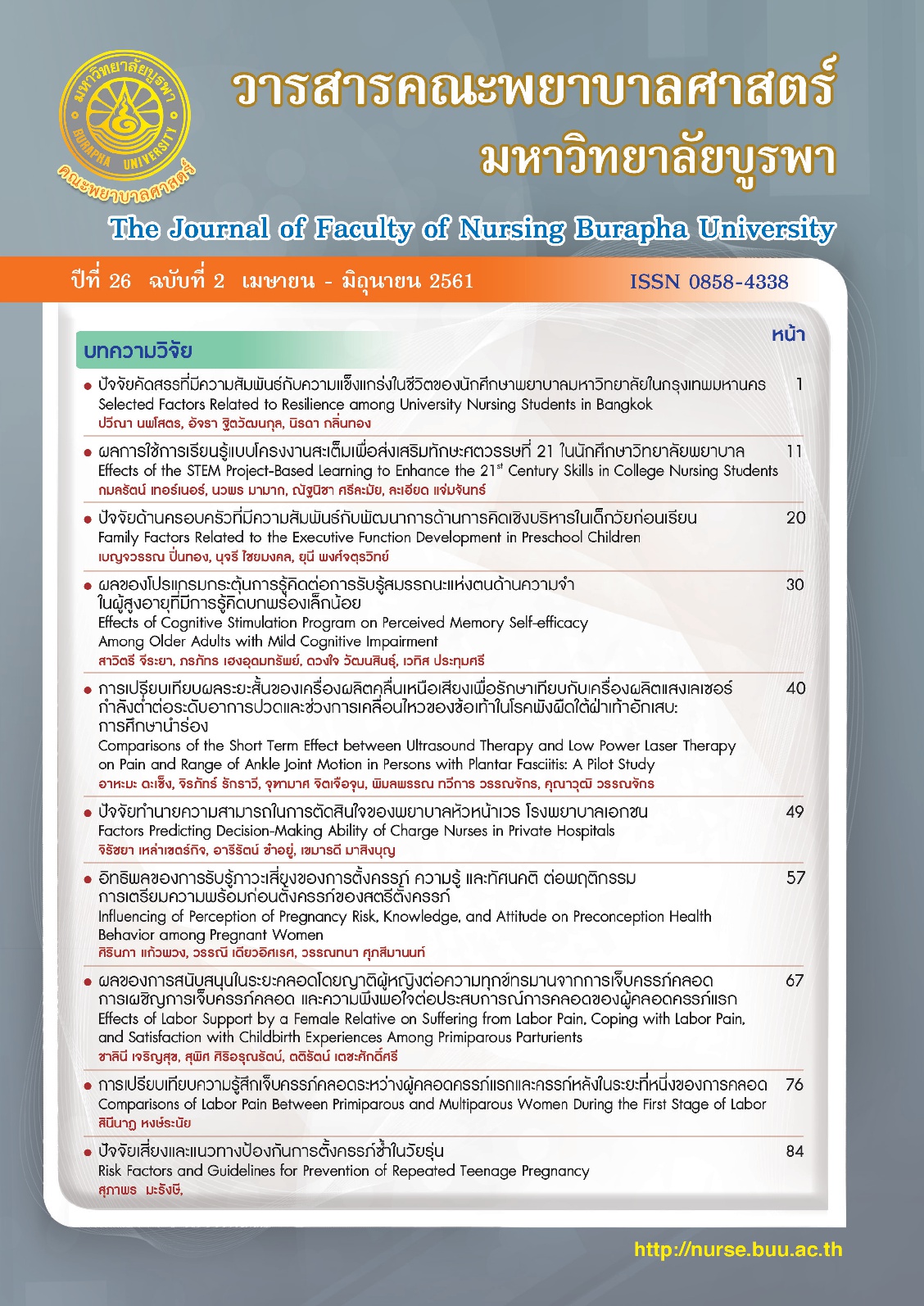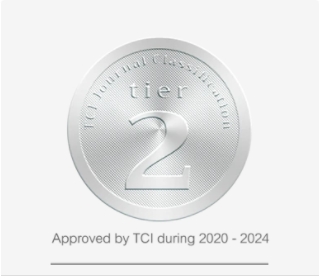การเปรียบเทียบความรู้สึกเจ็บครรภ์คลอดระหว่างผู้คลอดครรภ์แรกและครรภ์หลังในระยะที่หนึ่งของการคลอด
คำสำคัญ:
การเปรียบเทียบ, เจ็บครรภ์คลอด, ระยะที่หนึ่งของการคลอด, ผู้คลอดครรภ์แรก, ผู้คลอดครรภ์หลังบทคัดย่อ
บทคัดย่อ
การวิจัยครั้งนี้เป็นแบบพรรณนาเพื่อเปรียบเทียบความรู้สึกเจ็บครรภ์คลอดระหว่างผู้คลอดครรภ์แรกและครรภ์หลังในระยะที่หนึ่งของการคลอด กลุ่มตัวอย่างคัดเลือกโดยการสุ่มตัวอย่างแบบหลายขั้นตอน จำนวน 100 คน เป็นหญิงที่มาคลอดในโรงพยาบาลชุมชนในจังหวัดเชียงรายในปี พ.ศ. 2559 เครื่องมือที่ใช้ในการเก็บรวบรวมข้อมูล ประกอบด้วย แบบบันทึกข้อมูลทั่วไปและข้อมูลการคลอด และแบบประเมินความรู้สึกเจ็บครรภ์คลอดของแมคกิลล์ฉบับย่อภาษาไทย มีค่าความเชื่อมั่น KR-20 เท่ากับ .74 วิเคราะห์ข้อมูลด้วยสถิติพรรณนา และการทดสอบไคสแควร์
ผลการวิจัยพบว่า ในระยะปากมดลูกเปิดช้า (1-3 ซม.) และในระยะปากมดลูกเปิดเร็วตอนต้น (4-7 ซม.) ผู้คลอดครรภ์แรกรู้สึกเจ็บครรภ์ลักษณะจี๊ดมากกว่าผู้คลอดครรภ์หลัง ( 2 =8.01, p<.01 และ 2 =3.75, p<.05 ตามลำดับ) และในระยะปากมดลูกเปิดเร็วตอนปลาย (8-10 ซม.) ผู้คลอดครรภ์แรกรู้สึกเจ็บครรภ์ลักษณะจี๊ดและเกร็งมากกว่าผู้คลอดครรภ์หลัง ( 2 =12.73, p<.001 และ 2 =4.59, p<.05 ตามลำดับ) ผลการวิจัยมีข้อเสนอแนะว่า พยาบาลผดุงครรภ์ควรนำผลการวิจัยไปพัฒนาแนวปฏิบัติทางการพยาบาลเพื่อลดการปวดในระยะที่หนึ่งของการคลอดในผู้คลอดครรภ์แรก
References
Cunningham, F.G., Leveno, K.J., Bloom, S.L., Spong, C.Y., Dashe, J.S., Hoffman, B.L., Casey, B.M., & Sheffield, J.S. (2014). William obstetrics (24th ed). New York: McGraw-Hill.
Kittisomprayoonkul, W., Klaphajone, J., & Kovindha, A., (2006). Thai short-form McGill Pain Questionnaire. Journal of Thai Rehabilitation Medicine, 14(3), 83-92. [in Thai]
Labor, S., & Maguire, S. (2008). The pain of labour. Reviews in Pain, 2(2), 15-19.
Laurson, M., Johansen, C., & Hedegaard, M. (2009). Fear of childbirth and risk for birth complication in nulliparous women in the Danish national birth cohort. British Journal of Obstetrics and Gynaecology, 116(10), 1350-1355.
Lowe, N. K. (1992). Differences in first and second stage labor pain between nulliparous and multiparous women. Journal of Psychosomatic Obstetrics & Gynecology, 13(4), 243-253.
Lowe, N. K. (2002). The nature of labor pain. American Journal of Obstetrics and Gynecology, 189(5), S16-S24.
Melzack, R. (1983). Pain measurement and Assessment. New York: Raven Press.
Prasertsri, N., & Tirapaiwong, Y. (2013). Pain management: Cultural diversity. Journal of Nursing and Education, 6(2), 2-10. [in Thai]
Power, S., Bogossian, F. E., Strong, J., & Sussex, R. (2016). A critical analysis of women’s descriptions of labor pain based on the McGill Pain Questionnaire. International Journal of Childbirth, 6(4), 223-233.
Sakorntanun, W., Chatchawan, U., & Hongrattana, K. (2012). The characteristics of labor pain during the active phase of primipara. Journal of Medical Technology and Physical Therapy, 24(2), 191-200. [in Thai]
Tanglakmankhong, K., Chotiga, P., Ngamkham, S., & Thaewpia, S. (2016). Labor pain assessment and management by using RAT model framework. Journal of Phrapokklao Nursing College, 27(Suppl 1), 160-169. [in Thai]
Thai association for the study of pain. (2009). Clinical guidance for acute pain management. Bangkok: Thai association for the study of pain. [in Thai]
Thithapandha, A. (2011). Pain: concepts & mechanism. Retrieved from https://ascannotdo.wordpress.com/.../pain-concept-mecha... [in Thai]
Steen, M. (2008). Understanding perineal pain: Women’s descriptions. British Journal of Midwifery, 16(6), 383-393.
Yazbek, M. (2016). Development of a labor pain assessment instrument. Africa Journal of Nursing and Midwifery, 18(1), 4-26.





